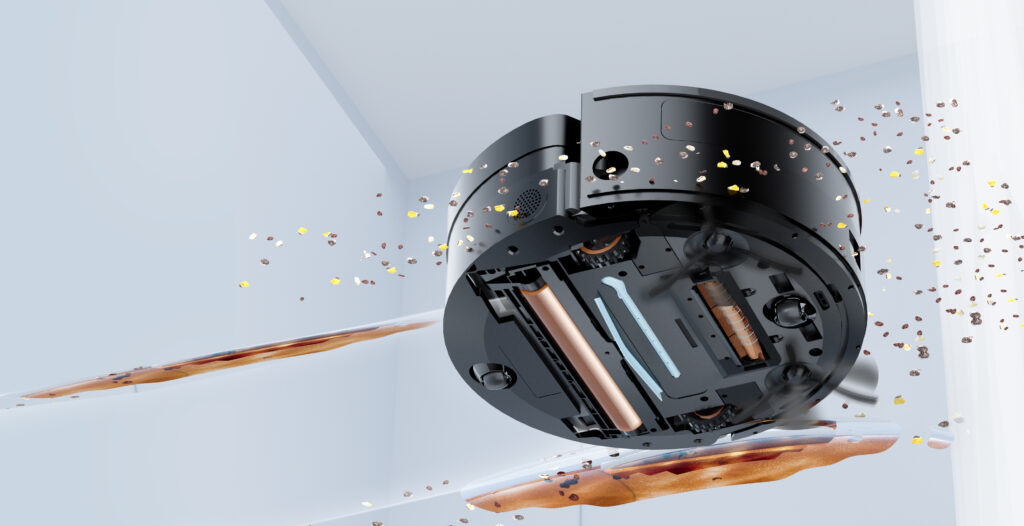
In today’s fast-paced world, people constantly look for ways to simplify their lives and save time. The technology aims to meet this demand by developing robot vacuum cleaners. These handy devices autonomously clean your floors, freeing your time for more critical tasks. But how do these robots adapt to different floor surfaces, such as carpets, tiles, or hardwood, to ensure effective cleaning in diverse environments? This blog post will explore the mechanisms and technologies that allow robot vacuums to adapt and clean various floor surfaces efficiently.
Understanding Different Floor Surfaces
Before diving into how robot vacuum cleaners adapt to different floor surfaces, it’s essential to understand the characteristics of these surfaces. Each type of flooring has unique properties that can affect cleaning effectiveness. Let’s take a closer look at the most common floor surfaces:

- Carpets: Carpets come in various thicknesses and materials, such as wool, nylon, or polyester. They can trap dirt, debris, and allergens, making cleaning more challenging.
- Tiles: Tile flooring, including ceramic, porcelain, or stone, is typically smooth and resistant to stains. However, dirt and dust can accumulate in grout lines, requiring special attention during cleaning.
- Hardwood: Hardwood floors offer a beautiful aesthetic and withstand heavy foot traffic. They need regular cleaning to maintain their shine and to prevent scratches or damage from debris.
Now that we have a basic understanding of floor surfaces, let’s delve into how robot vacuum cleaners adapt to each of these surfaces.
Robot Vacuum Cleaners Adaptive Cleaning Technologies
Robot vacuum cleaners utilize various adaptive cleaning technologies to ensure effective cleaning on different floor surfaces. These technologies enable the robots to adjust their cleaning methods, suction power, and navigation techniques according to the specific floor surface they encounter. Here are some of the key technologies at work:
Surface Detection Sensors
A crucial aspect of robot vacuum cleaners is their ability to detect and recognize different floor surfaces. Surface detection sensors, such as optical or infrared, help robots identify flooring variations. By analyzing differences in reflectivity or texture, the robots can adjust their cleaning strategy accordingly. For example, when a robot detects a carpeted area, it may increase suction power to remove embedded dirt efficiently.
Brush Rollers and Agitators
Robot vacuums feature brush rollers and agitators to agitate and dislodge dirt from floor surfaces. These cleaning components are strategically designed to tackle specific floor types. For instance, robots may have bristle brushes suitable for carpets, rubberized meetings for hardwood, or both for versatility. The bushes and agitators use the robot’s suction power to effectively clean different surfaces.
Suction Power and Cleaning Modes
Suction power and cleaning modes are other critical factors in adapting to different floor surfaces. Robot vacuum cleaners offer multiple cleaning modes, such as auto, regular, or high-power. The suction power can be adjusted based on the surface type. For example, a higher suction power may be necessary for carpets to remove deep-seated dirt, while a lower power setting may be suitable for delicate hardwood floors.
Intelligent Navigation Algorithms
Efficient cleaning relies on intelligent navigation algorithms that enable robot vacuums to effectively navigate and clean different floor surfaces. These algorithms utilize various sensors, such as cliff sensors, to avoid falls and bumpers to detect obstacles. By understanding the layout of the room and the type of flooring encountered, the robot vacuum can optimize cleaning paths and adjust cleaning behaviors accordingly.
Virtual Wall Barriers
To further enhance adaptability, some robot vacuum cleaners offer virtual wall barriers. These barriers create invisible boundaries that prevent a robot from entering specific areas. Users can define rooms where the robot should not clean by setting virtual walls or using physical barriers. This feature is beneficial when dealing with a mix of floor surfaces or areas that require special attention.
Tips for Effective Cleaning on Different Floor Surfaces
While robot vacuum cleaners are designed to adapt to different floor surfaces, there are some tips you can follow to maximize their cleaning effectiveness:
- Clear the Floor: Before starting the cleaning cycle, remove any obstacles, loose cables, or small objects that could impede the robot’s movement. This ensures a seamless cleaning process and avoids unnecessary interruptions.
- Use Virtual Walls: If you have a mix of floor surfaces or specific areas you want the robot to avoid, use virtual wall barriers or physical barriers to guide the vacuum cleaner and prevent it from crossing unwanted boundaries.
- Regular Maintenance: Keep your robot vacuum in top shape by regularly cleaning its brushes and filters. This prevents debris buildup, ensures optimal performance, and prolongs your device’s lifespan.
- Understand Cleaning Modes: Familiarize yourself with the different cleaning modes your robot vacuum cleaner offers. Experiment with various settings to find the optimal method for each floor surface in your home.
In Conclusion
Robot vacuum cleaners have revolutionized the way we clean our homes by offering automatic and efficient cleaning solutions. These robots utilize adaptive cleaning technologies to adapt to different floor surfaces, such as carpets, tiles, or hardwood. Surface detection sensors, brush rollers, suction power adjustment, intelligent navigation algorithms, and virtual wall barriers are crucial elements that allow them to clean effectively on diverse floor types. By following some simple tips, you can further enhance the performance of your robot vacuum cleaner and maintain clean floors effortlessly. Embrace this technological innovation, and let these cleaning robots make your life easier and your home cleaner.























